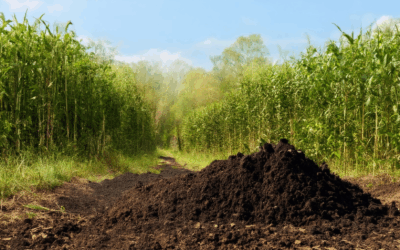Unlocking the potential of biochar-enhanced soil conservation offers a promising pathway to improve agricultural productivity and environmental sustainability. While the concept of using biochar—a carbon-rich material produced from organic waste—to enhance soil health has gained traction, it remains shrouded in both excitement and controversy. Proponents argue that biochar can significantly boost soil fertility, reduce erosion, and sequester carbon, making it a valuable tool for sustainable land management. However, critics raise concerns about its impact on local ecosystems and the potential for misuse. This article delves into the benefits, controversies, and best practices surrounding biochar-enhanced soil conservation, providing a comprehensive guide to understanding its role in modern farming practices. By exploring the science behind biochar application methods, the challenges of proper usage, and real-world case studies, we aim to shed light on how biochar can be effectively integrated into agricultural systems while addressing the broader implications for eco-system balance.
Key Takeaways
– Optimal Biochar Application Rates: Apply 1-2 inches of biochar per acre initially, with reapplications every 1-3 years based on soil type, climate, and plant needs.
– Soil Health Considerations: sandy soils may require more frequent applications, while healthy soils may need less. Combine with compost for enhanced effectiveness.
– Limitations of Biochar: Avoid using biochar in high pH-tolerant plants like rhododendrons, nutrient-rich soils, pH-sensitive crops, and controlled environments.
– Long-Term Carbon Retention: Biochar can store carbon for over 1000 years, contributing to carbon sequestration and sustainable agriculture.

The Controversy Surrounding Biochar
Biochar, a carbon-rich material derived from the pyrolysis of organic waste, has sparked significant debate due to its potential environmental and health risks. While it offers numerous benefits, such as carbon sequestration and soil enhancement, concerns about contamination with toxic substances like dioxins, furans, and polycyclic aromatic hydrocarbons (PAHs) have raised alarms.
Dangerous Compounds: During the pyrolysis process, high temperatures can release harmful chemicals from the organic feedstock. Dioxins, known carcinogens, and furans, which can cause liver damage, are among the contaminants found in biochar. Additionally, chlorinated hydrocarbons such as polychlorinated biphenyls (PCBs) may also be present, posing serious health risks if ingested or inhaled.
Environmental Impact: The disposal of biochar, despite its sustainable origins, can lead to secondary pollution. If used as a soil amendment, these contaminants might leach into the ground, contaminating crops and potentially entering the food chain. Misuse in water systems or landfills could exacerbate environmental harm.
Pollutant Carrier Risk: Biochar may act as a medium for transporting other pollutants, such as heavy metals like mercury and lead, from the original waste materials. This underscores the importance of ensuring biochar’s purity before application.
Regulatory Gaps: Current regulations lack stringent standards for biochar contaminants, leaving room for unsafe products to enter the market. Establishing clear guidelines for acceptable levels of dioxins, furans, and other toxins is crucial to protect users and the environment.
Production Controls: Variations in feedstock and pyrolysis conditions can influence contamination levels. Optimizing production parameters could help mitigate toxin release, but this requires careful monitoring and control.
Public Awareness and Responsible Use: Educating consumers and farmers about biochar’s potential risks is essential. Understanding these dangers can guide responsible usage, possibly in controlled settings to minimize exposure risks.
Research and Innovation: Advances in pyrolysis technology may offer solutions to reduce toxics in biochar. Collaborative efforts between researchers, policymakers, and industries could pave the way for safer, more effective biochar production and application.
In conclusion, while biochar presents promising environmental benefits, its production and use must address contamination risks to ensure it becomes a safe and sustainable solution.
How Does Biochar Contribute to Soil Improvement?
Biochar significantly enhances soil health and functionality through several mechanisms. Its application improves soil structure, nutrient availability, and overall agricultural productivity. Here’s a breakdown of its contributions:
- Nutrient-Rich: Biochar adds essential nutrients like phosphorus, potassium, and magnesium to the soil, promoting plant growth and reducing the need for chemical fertilizers.
- Microbial Boost: Biochar acts as a habitat for soil microbes, enhancing decomposition and nutrient cycling, which strengthens soil organic matter.
- Carbon Storage: As a carbon-rich material, biochar sequesters carbon, contributing to climate resilience and reducing greenhouse gas emissions.
- Water Retention: Biochar improves soil moisture retention, reducing runoff and drought risks, especially in arid regions.
- PH Balance: Biochar helps regulate soil pH, making it more conducive to plant growth and reducing acidification issues.
- Reduced Compaction: Its porous structure prevents soil from becoming too dense, allowing better root penetration and oxygen circulation.
By incorporating biochar into farming practices, farmers can create healthier soils that yield better crops and support more robust ecosystems. Pyrolysium advocates for sustainable solutions like biochar to promote eco-friendly agriculture and combat climate change effectively. Explore our resources to learn more about implementing biochar in your farming operations: Pyrolysium .

Can You Put Too Much Biochar in Soil?
Yes, applying too much biochar can harm your plants and disrupt soil health. Here’s why:
- Soil pH Imbalance: Biochar tends to increase soil acidity due to its production during pyrolysis. Over-application can elevate the pH beyond many plants’ preferred ranges, potentially stressing sensitive vegetation.
- Nutrient Competition: Excessive biochar may sequester essential nutrients like phosphorus and zinc, reducing their availability for plants and encouraging microbial competition, which can hinder plant growth.
- Soil Structure Issues: In large quantities, biochar can make soil too coarse, impeding root penetration and water infiltration, which are vital for plant survival and productivity.
For optimal results, consider applying biochar at recommended rates, typically around 5% by weight (approximately 50 kg per square meter for agricultural uses), and monitor your plants’ reactions to determine the suitable amount for your specific situation.

How Often Should You Add Biochar to Soil?
Your soil’s condition and agricultural goals will determine the ideal frequency of biochar addition. Here are some key considerations:
- Initial Application Rate: A typical recommendation is to apply 1-2 inches of biochar per acre of land. This initial application can provide long-lasting benefits.
- Frequency of Reapplication: Depending on soil type, climate, and application method, biochar may need to be reapplied every 1-3 years. Frequent applications can enhance soil structure and nutrient availability.
- Soil Type and Condition: Sandy soils may require more frequent applications compared to clay soils, which hold nutrients better. Healthy, fertile soils generally need less biochar as they already have good structure and nutrients.
- Climate Factors: In regions with high rainfall or intense decomposition, biochar may break down faster, necessitating more regular applications. In contrast, arid climates may allow biochar to last longer.
- Plant Requirements: Plants with higher nutrient demands, such as vegetables or fruit trees, may benefit from more frequent biochar applications to sustain soil fertility.
- Composting and Amendments: Applying biochar alongside compost or other organic matter can enhance its effectiveness and reduce the frequency of future applications.
For optimal results, monitor your soil’s health and adjust the biochar application rate accordingly. Regular testing can help determine if your soil is absorbing and utilizing the biochar effectively, allowing you to adjust your schedule as needed.
When Not to Use Biochar
Biochar, a versatile and beneficial soil amendment derived from organic material through pyrolysis, offers numerous advantages for soil health and plant growth. However, its effectiveness can vary depending on specific circumstances. Here are scenarios where biochar may not be the optimal choice:
- High Soil pH Tolerance Required: Biochar tends to increase soil pH, making it less suitable for plants that thrive in acidic conditions. Ericaceous plants, such as rhododendrons and azaleas, are particularly sensitive to pH changes and may experience stress if biochar is applied.
- Already Nutrient-Rich Soil: In soils that are already fertile or well-nourished, biochar may not provide significant benefits. It is most effective in enhancing nutrient availability and microbial activity in less fertile soils.
- Crops with Specific pH Requirements: Vegetables like tomatoes and peppers, which prefer slightly acidic to neutral soil, may struggle if biochar raises the pH beyond their optimal range. Similarly, legumes and other pH-sensitive crops may exhibit poor growth under such conditions.
- Excessive Application: Overusing biochar can overwhelm the soil’s microbial community, potentially disrupting its natural balance. Applying moderate amounts ensures optimal benefits without causing harm.
- Controlled Environment Needs: In hydroponic systems or greenhouses where precise pH control is crucial, biochar may not be the best solution. Other amendments or methods tailored for such environments are often preferred.
By considering these factors, gardeners and farmers can decide whether biochar aligns with their specific needs, ensuring the best outcomes for their plants and soil health.

How Long Can Biochar Keep Carbon in the Soil?
Biochar, produced through the process of pyrolysis, contains a stable form of carbon known as polycyclic aromatic carbon. Research indicates that this stable carbon can persist in the soil for over 1000 years, irrespective of the soil type or climate conditions. This long-lasting stability contributes significantly to carbon sequestration efforts.
Additionally, biochar contains semi-persistent carbon, which can remain in the soil for approximately 50 to 100 years, depending on the specific soil environment and climatic conditions. While this component has a shorter lifespan compared to the stable carbon, its presence still aids in enhancing soil health and further reducing greenhouse gas emissions.
The combination of stable and semi-persistent carbons ensures that biochar effectively traps and stores carbon for extended periods, making it a valuable tool for combating climate change and promoting sustainable agricultural practices.
Conclusion
Biochar’s ability to retain carbon in the soil for over 1000 years, supported by the persistence of semi-persistent carbon, underscores its potential as a durable solution for carbon sequestration. This characteristic makes biochar a promising resource for long-term environmental benefits.




0 Comments